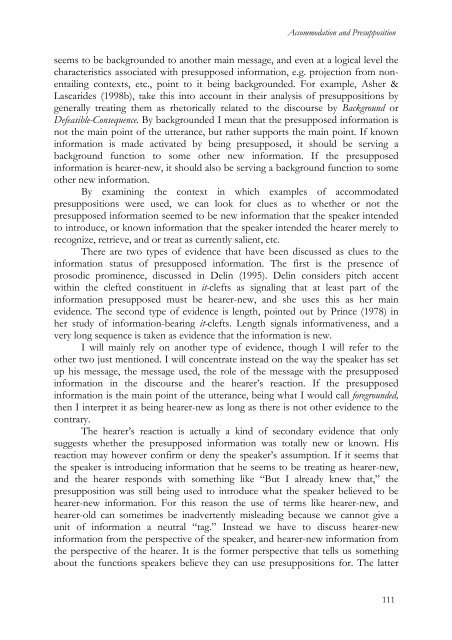Presuppositions in Spoken Discourse
Presuppositions in Spoken Discourse
Presuppositions in Spoken Discourse
Create successful ePaper yourself
Turn your PDF publications into a flip-book with our unique Google optimized e-Paper software.
Accommodation and Presupposition<br />
seems to be backgrounded to another ma<strong>in</strong> message, and even at a logical level the<br />
characteristics associated with presupposed <strong>in</strong>formation, e.g. projection from nonentail<strong>in</strong>g<br />
contexts, etc., po<strong>in</strong>t to it be<strong>in</strong>g backgrounded. For example, Asher &<br />
Lascarides (1998b), take this <strong>in</strong>to account <strong>in</strong> their analysis of presuppositions by<br />
generally treat<strong>in</strong>g them as rhetorically related to the discourse by Background or<br />
Defeasible-Consequence. By backgrounded I mean that the presupposed <strong>in</strong>formation is<br />
not the ma<strong>in</strong> po<strong>in</strong>t of the utterance, but rather supports the ma<strong>in</strong> po<strong>in</strong>t. If known<br />
<strong>in</strong>formation is made activated by be<strong>in</strong>g presupposed, it should be serv<strong>in</strong>g a<br />
background function to some other new <strong>in</strong>formation. If the presupposed<br />
<strong>in</strong>formation is hearer-new, it should also be serv<strong>in</strong>g a background function to some<br />
other new <strong>in</strong>formation.<br />
By exam<strong>in</strong><strong>in</strong>g the context <strong>in</strong> which examples of accommodated<br />
presuppositions were used, we can look for clues as to whether or not the<br />
presupposed <strong>in</strong>formation seemed to be new <strong>in</strong>formation that the speaker <strong>in</strong>tended<br />
to <strong>in</strong>troduce, or known <strong>in</strong>formation that the speaker <strong>in</strong>tended the hearer merely to<br />
recognize, retrieve, and or treat as currently salient, etc.<br />
There are two types of evidence that have been discussed as clues to the<br />
<strong>in</strong>formation status of presupposed <strong>in</strong>formation. The first is the presence of<br />
prosodic prom<strong>in</strong>ence, discussed <strong>in</strong> Del<strong>in</strong> (1995). Del<strong>in</strong> considers pitch accent<br />
with<strong>in</strong> the clefted constituent <strong>in</strong> it-clefts as signal<strong>in</strong>g that at least part of the<br />
<strong>in</strong>formation presupposed must be hearer-new, and she uses this as her ma<strong>in</strong><br />
evidence. The second type of evidence is length, po<strong>in</strong>ted out by Pr<strong>in</strong>ce (1978) <strong>in</strong><br />
her study of <strong>in</strong>formation-bear<strong>in</strong>g it-clefts. Length signals <strong>in</strong>formativeness, and a<br />
very long sequence is taken as evidence that the <strong>in</strong>formation is new.<br />
I will ma<strong>in</strong>ly rely on another type of evidence, though I will refer to the<br />
other two just mentioned. I will concentrate <strong>in</strong>stead on the way the speaker has set<br />
up his message, the message used, the role of the message with the presupposed<br />
<strong>in</strong>formation <strong>in</strong> the discourse and the hearer’s reaction. If the presupposed<br />
<strong>in</strong>formation is the ma<strong>in</strong> po<strong>in</strong>t of the utterance, be<strong>in</strong>g what I would call foregrounded,<br />
then I <strong>in</strong>terpret it as be<strong>in</strong>g hearer-new as long as there is not other evidence to the<br />
contrary.<br />
The hearer’s reaction is actually a k<strong>in</strong>d of secondary evidence that only<br />
suggests whether the presupposed <strong>in</strong>formation was totally new or known. His<br />
reaction may however confirm or deny the speaker’s assumption. If it seems that<br />
the speaker is <strong>in</strong>troduc<strong>in</strong>g <strong>in</strong>formation that he seems to be treat<strong>in</strong>g as hearer-new,<br />
and the hearer responds with someth<strong>in</strong>g like “But I already knew that,” the<br />
presupposition was still be<strong>in</strong>g used to <strong>in</strong>troduce what the speaker believed to be<br />
hearer-new <strong>in</strong>formation. For this reason the use of terms like hearer-new, and<br />
hearer-old can sometimes be <strong>in</strong>advertently mislead<strong>in</strong>g because we cannot give a<br />
unit of <strong>in</strong>formation a neutral “tag.” Instead we have to discuss hearer-new<br />
<strong>in</strong>formation from the perspective of the speaker, and hearer-new <strong>in</strong>formation from<br />
the perspective of the hearer. It is the former perspective that tells us someth<strong>in</strong>g<br />
about the functions speakers believe they can use presuppositions for. The latter<br />
111











